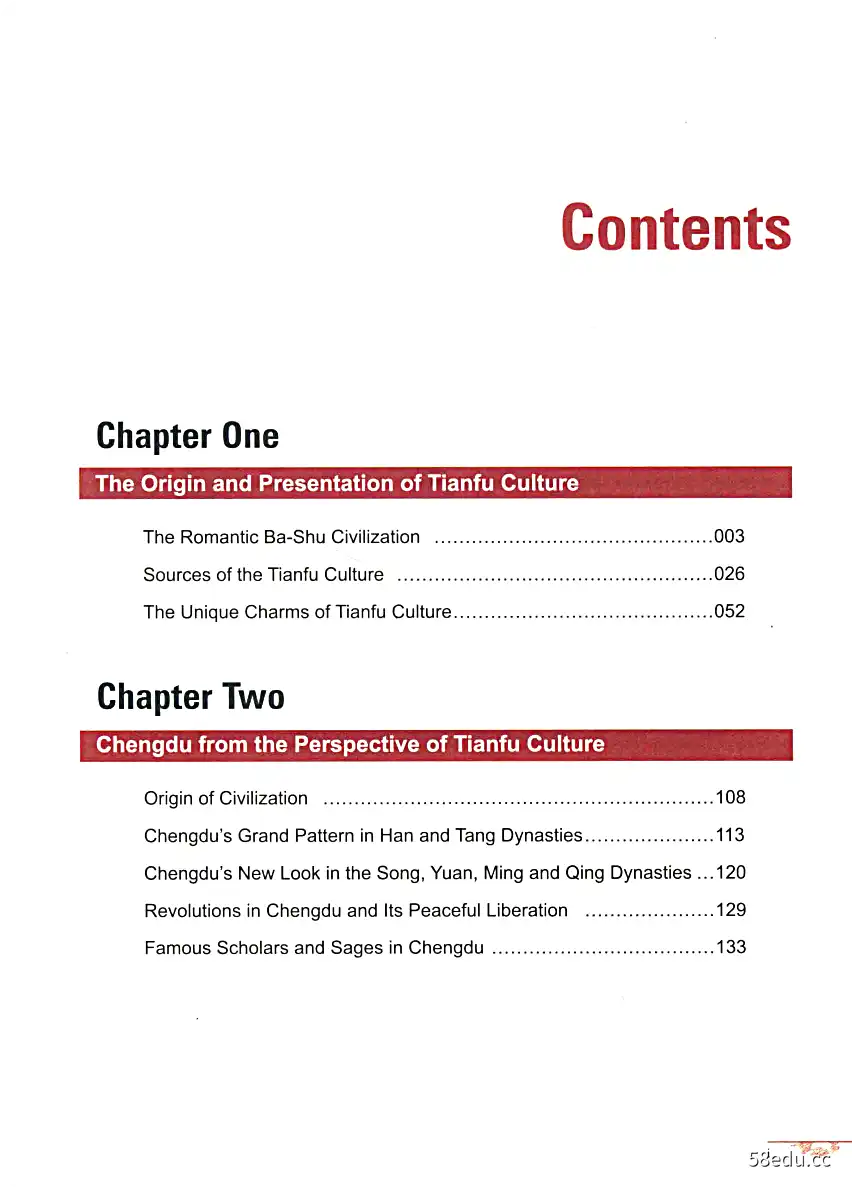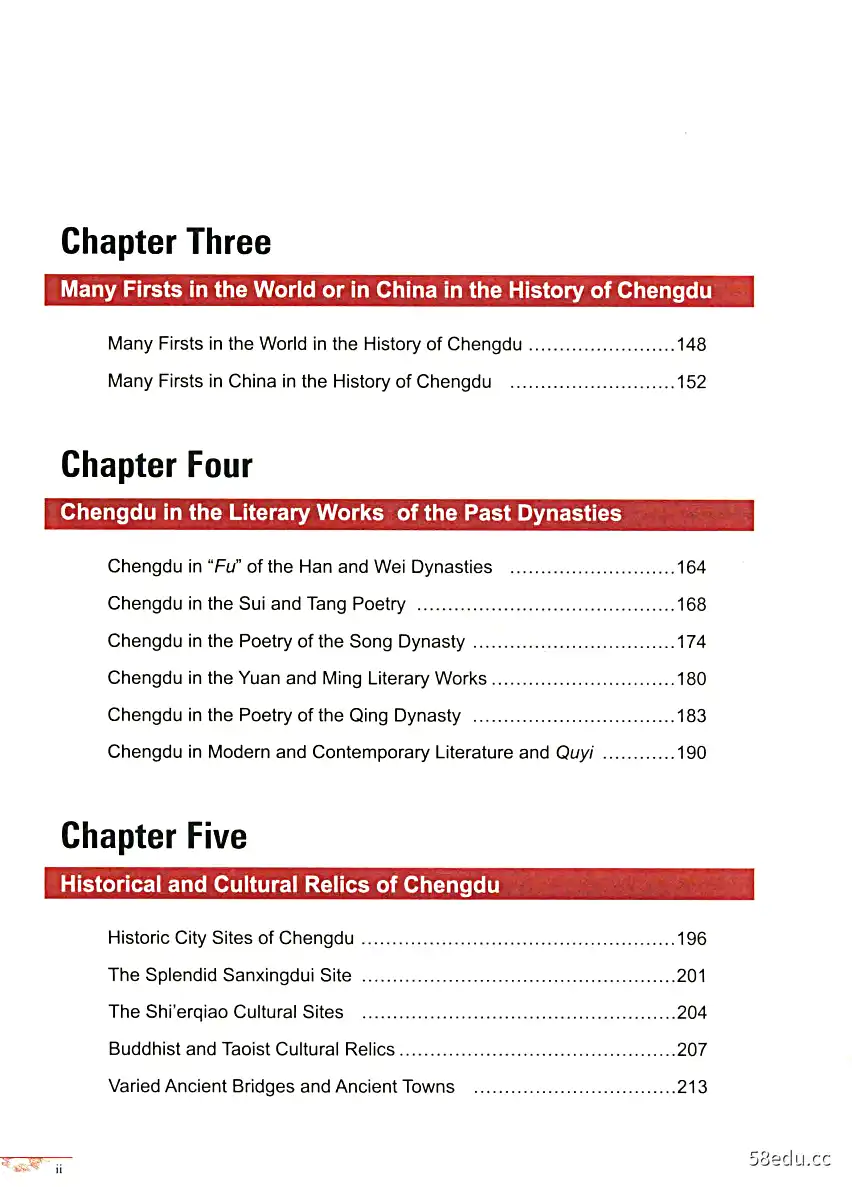《天府文化与成都的现代化追求》谭平,冯和一,周翔宇等著;彭蕴希,谭俊峰,姚键译|(epub+azw3+mobi+pdf)电子书下载
图书名称:《天府文化与成都的现代化追求》
- 【作 者】谭平,冯和一,周翔宇等著;彭蕴希,谭俊峰,姚键译
- 【页 数】 266
- 【出版社】 成都:四川大学出版社 , 2021.01
- 【ISBN号】978-7-5690-4106-4
- 【价 格】138.00
- 【分 类】文化史-成都-英文
- 【参考文献】 谭平,冯和一,周翔宇等著;彭蕴希,谭俊峰,姚键译. 天府文化与成都的现代化追求. 成都:四川大学出版社, 2021.01.
图书封面:
图书目录:


《天府文化与成都的现代化追求》内容提要:
《天府文化与成都的现代化追求》内容试读
Chapter One
The Origin and Presentation
of Tianfu Culture
Located in the core and most prosperous region of Sichuan Province the world-renovated
Land of Abundance,Chengdu covers an area of 14,334 square kilometers and boasts abeautiful natural environment and profound cultural context.In spite of more than 4,000 yearsof ups and downs such as the collision and fusion of multiple civilizations and numerous naturaldisasters and man-made calamities,this city has risen like a phoenix from the ashes with hertenacious vitality and creativity.Her humanistic character possesses not only the generality of
Chinese civilization,but also the outstanding individuality nourished by the local nature andculture and sharpened by her unique historical circumstances(Fig.1).
Tianfu
the Modern Pursuit
Culture and of Chengdu
In April 2017,Chengdu set the goal of "deepening reform and opening-up,focusingon innovation-driven development,striving for constructing a national central city that fullyembodies the new development philosophy"with the heritage of the Ba-Shu civilization,development of Tianfu Culture,and construction of a"World Cultural City"as its cultural mission.
The new concept of "Tianfu Culture"mainly refers to the city's cultural values-"Innovationand Creation,Fashion and Elegance,Optimism and Tolerance,Kindness and Public Welfare,"which are derived from the cultural and historical accumulation of more than 2,300 years,greatly enriched by the striking achievements thanks to the reform and opening-up policy,andleading Chengdu to optimize and highlight the cultural pursuit.As for over 160 million Chengduresidents,"Tianfu Culture"is not only a description of cultural individuality,but also a guide tocultural behaviors and an important measure to construct Chengdu into a World Cultural City aswell.For this reason,the first question this book is going to answer is what the soil for giving thebirth of Tianfu Culture is(Sources of Living Water or Civilization)and what Tianfu culture means.
Fig.I Chengdu with a sight of faraway snow mountain
002
Chapter One
The Origin and Presentation
of Tianfu Culture
The Romantic Ba-Shu Civilization
The Ba-Shu culture is long-standing and well established.According to the demonstrationby archaeologists,the Ba-Shu culture has the history of more than 5,000 years,and togetherwith Central Plain Culture,Qi-Lu Culture,Jing-Chu Culture and Wu-Yue Culture constitutes themain regional culture system of ancient China,making a unique contribution to the formationand development of Chinese culture.Thus,some specialists regard the land of Ba-Shu not onlyas one of the cradles of Chinese people,but also one of the birthplaces of world civilization.
With respect to the relationship of the Ba-Shu culture and Chinese civilization,Li Xueqing,aprofessor from Tsinghua University,an archaeologist and the chief scientist of the Project for
Chronology of Xia,Shang and Zhou dynasties,indicated,"It can be asserted that,if there wasn'tthe in-depth study of the Ba-Shu culture,the complete image of the origin and developmentof Chinese civilization cannot be formed.In consideration of the characteristic of the Ba-Shuculture,and its relationship with cultures of central plains,the west and the south of ancient
China,lots of problems regarding Chinese civilization probably could only be solved by meansof research in the Ba-Shu culture."
1.Geographic Features of the Ba-Shu Land
The Ba-Shu cultural region is a territorial community located in Southwest China,with the
Sichuan Basin as the center and combining the culture-related,custom-resembled surrounding
00357
Tianfu
the Modern Pursuit
Culture and of Chengdu
areas.Its central domain,lying in the central inland area of the upper reaches of Yangtze River,is divided by the line of Longmen Mountain-Daliang Mountain into two parts,with the Sichuan
Basin in the east,and the Western Sichuan Plateau and mountain regions in the west.Withnumerous rivers,diverse landforms and abundant animal and plant resources,it is a treasureland of the most stable agricultural civilization in Western China.Its geometric features andcultural context have decided that the cultural origin of this area (now equivalent to the areaof Sichuan and Chongqing)was not only influenced by the outside civilizations,but moreimportantly,shaped by its own resources and conditions.
The leading authorities in Chinese historiography in the 20th century,such as Xu Zhongshu(1898-1991),Gu Jiegang (1893-1980)and others,all agreed to the above-stated judgment.
From 1995 to 2003,eight archaeological sites of historic cities were discovered successivelyin the Chengdu Plain,including Baodun Site in Xinjin County,Ancient City Site in Pidu District,
Yufucun Site in Wenjiang District,Mangcheng Site in Dujiangyan City,Shuanghe and Zizhu
Sites in Chongzhou City,Yandian and Gaoshan Ancient City Sites in Dayi County.Thesescattering ancient city sites equivalent to political centers in the ancient time reveal that it wasvery hard to establish fixed political centers due to frequent flooding in the Chengdu Plain beforethe flood-control project by Li Bing.From another point of view,this phenomenon could reflectthe consciousness of hardship of residents in the ancient Shu.Historians and archaeologiststhink that these sites represent the chiefdom stage in development seen from the anthropology.
The ancient sites in the Chengdu Plain are the oldest,largest and most-densely-distributedancient site groups in Southwestern China.These discoveries are profoundly exciting inthe academic field.The international archaeological field also showed great concern on theexcavation and research of the sites and joined in these processes.In this case,the Chinese-American and Chinese-Japanese archaeological research teams were formed successively.
From 2005 to 2007,the International Archaeological Research Team for Chengdu Plain Ancient
Sites were formed by Chengdu Municipal Cultural Relics and Archaeology Research Institute,the Department of Archaeology of Beijing University,Department of Anthropology of Taiwan
4写004
Chapter One
The Origin and Presentation
of Tianfu Culture
University,Department of Art History and Archaeology of Washington University in St.Louis,and Department of Anthropology of Harvard University.At first,this team made a thoroughsurvey of the ancient city site in Pidu District as well as its surrounding areas.The researchreport suggested that the archaeological evidence of social complexity of the Chengdu Plaindemonstrated a social-complexity development process that distinguishes from but may not betotally irrelevant with other regions of China.This would contribute to the comprehension of thesocial complexity processes of different regions of China and even the East Asian areas on the
scale of different spaces,different social structures and different times.
Duan Yu (1953-),a researcher of Sichuan Academy of Social Sciences,indicated thatthe Sichuan Basin is an independent geographical unit with its elevation gradually droppingfrom the peripheral mountain to the central part of the basin,and the rivers also presenting anasymmetric centripetal structure.It was this centripetal structure,combined with the superiornatural conditions of the basin,that made it easy to attract the groups engaged in highlandagriculture in the peripheral mountainous areas to develop and settle down in the lowlands,and attract various ancient cultures to move to the Chengdu Plain in the central part of thebasin along the centripetal geographical structure formed by the descending river and mountainvalleys,thus providing a natural basis for the blending of ancient cultures and enabling the
Chengdu Plain to develop a developed ancient Shu civilization.Besides,as the Minjiang River,
Jialing River,Tuojiang River and Yangtze River flowed throughout the basin and radiated in alldirections,they have spread the ancient Shu civilization into other areas.This kind of centripetaland radiating power of the Ba-Shu culture has a strong humanistic shaping function,which,to a large extent,comes from its own unique geographical conditions.For thousands of yearssince the pre-Qin period,the same basic patterns have been maintained,and the Land of
Abundance has not only been able to regain its economic prosperity,but also can continue its
unique context and maintain its basic and consistent humanistic characters through vicissitudesafter vicissitudes (including the extinction of almost all the aborigines caused by two violent warslasting from the late Song Dynasty to early Yuan Dynasty,and from the late Ming Dynasty to
005多
Tianfu
the Modern Pursuit
Culture and of Chengdu
early Qing Dynasty,respectively).
As far as the relationship between natural geography and human geography is concerned,the Ba-Shu region,with an altitude drop of more than 5,000 meters,boasts almost all kinds ofgeological and geographical landscapes except the sea and desert,the rare biodiversity andabundant animal and plant species.In terms of its magic and magnificent beauty,there aremany well-known old sayings;for example,"the Jianmen Pass is the most dangerous in theworld;Kuimen Mountain,the most majestic;Qingcheng Mountain,the most secluded;Mount
Emei,the most beautiful."In addition,there is also a striking and years-carved primitive ecology,including snowy plains and glaciers holy as virgins,plateau sceneries where it seems thatpeople could almost capture stars,pick the moon,chase the wind and touch the clouds,andthe warm,simple and bold ethnic customs.Sichuan has 56 ethnic groups with a population of
4.6 million ethnic minorities,making it the second largest Tibetan area,the only Qiang people'ssettlement area and the largest Yi people's settlement area in the country.Religious cultureis rich in landscapes,rituals and classics.Sculptures,music,paintings and various intangiblecultural heritages on religious themes make people forget to return home.In particular,thecorridor of Tibetan,Qiang and Yi culture is colorful and enjoys the worldwide fame.
In history,one of the four outstanding poets of the early Tang Dynasty,Wang Bo(c.650-676),wrote "Thirty Poems on a Journey into Shu"praising the uniqueness of the Ba-Shu mountainsand waters,and lamenting "an excellent visit to the Heaven and a unique view of the universe."
Du Fu(712-770),the "Poem Saint"of the Tang Dynasty,took refuge in Chengdu after the "An-
Shi Rebellion,"but was treated well by the officials and people there.He wrote,"Traveling in thechangeable scenery of mountains and rivers,I suddenly found I was on the other side of the sky."
Obviously,the novelty of the Ba-Shu landscape dazzled and refreshed him.He also marveledat Chengdu's "reputation as a metropolis,where people are singing,dancing and playinginstruments."It was a music city full of vitality."Poetic Genius"Li Bai (701-762,from Jiangyou
County of Sichuan)praised the Three Gorges in his poem:"Leaving at dawn the White Kingcrowned with rainbow cloud,I have sailed a thousand miles through Three Gorges in a day.With
006
···试读结束···
作者:柳建华
链接:https://www.58edu.cc/article/1579660237923704834.html
文章版权归作者所有,58edu信息发布平台,仅提供信息存储空间服务,接受投稿是出于传递更多信息、供广大网友交流学习之目的。如有侵权。联系站长删除。